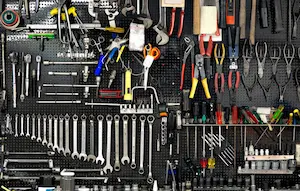How To Store A Car Long Term: Prep Your Car For Long-Term Storage
This post contains affiliate links.

Suppose you plan to store your car for the long term, perhaps due to an extended vacation or changing seasons. In this case, it’s crucial to take steps that will ensure your vehicle remains in good condition when you return. How to store a car long term?
To store a car long term:
- Thoroughly clean the car’s interior and exterior.
- Find a suitable storage facility.
- Drain or add fuel stabilizer into the fuel tank
- Change oils and fluids to prevent engine damage.
- Keep the battery charged.
- Prevent flat spots on tires with jack stands.
- Avoid using the parking brake to prevent fusing.
- Pest & Vermin Prevention: Protect the car from pests.
The following guide provides a detailed process to store your vehicle to keep it safe and ready to go when needed.
How To Prepare Your Car For Storage?
| Step | Description | Details |
| Interior and Exterior Cleaning | Thoroughly clean the car’s interior and exterior. | Wash the car and apply wax to protect the paint. Vacuum seats and flooring, remove food scrapsPlace silica gel packs to reduce odors, pests, and mold. |
| Choosing a Storage Location | Find a suitable storage facility. | Use a climate-controlled garage for protection.Use a breathable car cover if storing outdoors. |
| Fuel System Preparation | Prevent fuel degradation. | Add fuel stabilizer to a full gas tank and drive the car to distribute it. Alternatively, drain the fuel completely. |
| Fluid Maintenance | Change fluids to prevent engine damage. | Change the oil to remove contaminantsCheck brake fluid and coolant levels. |
| Battery Management | Keep the battery charged. | Use a battery tender remove and store the battery in a warm, dry place. |
| Tire Care | Prevent flat spots on tires. | Place the car on jack stands or overinflate tires. |
| Parking Brake and Brakes | Avoid using the parking brake. | Use wheel chocks instead. If on jack stands, ensure the brakes are disengaged. |
| Pest & Vermin Prevention | Protect the car from pests. | Block air intakes and exhaust pipes with steel wool, set traps,Use repellents like peppermint oil. Air out the cabin regularly. |
Storing a car in the long term can take a bit of preparation, but if you are clear about the steps, you can save quite a bit of time.
Interior and Exterior Cleaning
Start by thoroughly cleaning your car before putting it in storage. For the exterior, wash the car to remove dust and impurities. Feel free to apply a layer of wax, if you prefer, to prevent contaminants from damaging the paint.
For the interior, you can vacuum the seats and flooring. Take your time, work on removing the food scraps, and leave silica gel packs to absorb excess moisture.
These actions keep the interior and exterior of the car clean. This should help minimize the risk of your car catching nasties like:
- odors,
- pests, and
- mold.

Once cleaned, consider placing a plastic vapor barrier under the car if stored indoors. That will prevent water vapor buildup in an unheated garage.
You can also place a couple of sheets of cardboard underneath the car. This helps you to spot any leaks afterward.
Choosing a Storage Location
Indoor storage facilities like a clean, climate-controlled garage are best. This is because they offer protection from:
- fluctuating temperatures,
- dust and debris,
- moisture, and
- sun damage.
If indoor storage is not possible, you must cover your car. Use a breathable car cover that repels water while preventing mold. You can also wax the car before storage to protect its paint better.
Fuel System Preparation
Before storing your car, it’s essential to prevent moisture from accumulating inside the fuel tank. Fuel can also go bad after some time, so some preparation work will be needed.
Add a fuel stabilizer (paid link) to the gas tank, then fill it to full capacity. This combination will protect the fuel from breaking down and prevent rust formation in the tank.
After adding the stabilizer, drive your car for a few miles to make sure it’s well-distributed throughout the fuel system.
Another approach is to simply drain all the fuel out of your car. This approach ensures a dry system, meaning you do not have to worry about bad fuel. You just have to refuel your car with fresh fuel later.
This approach, however, requires a bit of technical skill since you need to locate the fuel line at the undercarriage. You then disconnect it to drain out the fuel.
Fluid Maintenance
This may be counterintuitive, but change the oil before storing your car.
This is because used oil often contains contaminants that can damage the engine over time. Fresh oil will also ensure your engine stays lubricated and protected. If you want to go the extra mile, change the oil again when restarting your car.
At the same time, double-check that your brake fluid and coolant levels are topped off with adequate antifreeze for colder climates.
Battery Management
Batteries may lose charges or simply die off when in long storage. A battery tender or trickle charger will keep your car battery charged throughout storage.

Battery tenders are designed to deliver a consistent, low-level charge to prevent overcharging. Install a battery tender (paid link) and connect it to your car battery if you have an outlet available nearby.
If you don’t have access to an outlet at your storage location, consider removing the battery. Then, store it in a warm, dry place where you can occasionally recharge it.
Tire Care
Prevent flat spots by placing your car on jack stands (paid link) to keep the vehicle off the ground. Flat spots can ruin your tires since they may not roll well when you drive them later.
Over time, the weight of the vehicle pressing down on the tires can cause deformation, particularly in cold weather.
Suppose if you are storing the vehicle longer than 6-12 months without driving. In this case, it’s best to replace the tires with old spare tires. keep eep the good tires elsewhere and reinstall then when reusing the car.
If using jack stands isn’t an option, slightly overinflate your tires to minimize the risk of flat spots. You can also occasionally come back and roll the car forward or backward slightly to change the pressure point on your tire.
Keep Your Car On Jack Stands – Spare The Brake
Avoid using the parking brake when storing a vehicle for an extended period. Brake pads can fuse with rotors if left for too long, so it’s best to use wheel chocks (paid link) instead.
If you have your car on jack stands, you will not need to worry about brakes. Simply release the handbrake and let the brake system disengage.
Rust buildup can also happen to cars in long-term storage. You can deal with this by ensuring dry air in your garage. Regular scrubbing with a wire brush can also help here.
Pest & Vermin Prevention
Pests and vermin can cause serious damage to your car’s wiring and interior. Rats can build nests in the intakes of your car, while cockroaches or spiders can easily make the interior of your car their home.
Prevent this by blocking the air intake and exhaust pipes with steel wool. Peppermint oil (paid link) and mothballs(paid link) are effective repellents to keep these nasty creatures away.
You can also place traps(paid link) around the car if someone can go to the garage and inside of the car sometimes. This is because someone has to come in to check the traps and clear whatever they catch.
It may also help to regularly open up the car doors and let some fresh air into the cabin. Regular human activity should deter pests from nesting near your car.
Things To Do To Keep The Car Operating In Long-Term Storage
Just because your car is in long-term storage does not mean you can simply leave it to sit idle. There are things you can regularly do to ensure the car remains operational while sitting in its storage.
Clean & Re-Protect The Exterior
Consider light cleaning and waxing the car while it is in long-term storage. This helps to further protect the car, especially the finishing and clear coat.
Regular cleaning also ensures your car gets some human activity around it, preventing pests and rodents from turning your car into their home.
System Maintenance
Periodically start your car and let it idle for a few minutes to keep the engine components lubricated.
If possible, run and operate some of the more important systems in the car, such as:
- Brakes – Press and release the brakes several times, and check for feel. It should feel regular and not spongy. Engage and release the hand brake, too.
- Transmission – With your foot on the brake, engage all the gears in your transmission system. It should operate and feel normal.
- Climate control – Turn on and operate the cooler or warmers in your car.
- Steering – Turn your steering fully on both ends. This allows the steering system to operate.
You can also check the oil to ensure that your engine is well-lubricated with good, high-quality oil. This step is even more important if you do not change out the old oil before storage.
You can also spray some fogging oil through the spark plug cavity to coat and protect the cylinders from corrosion.
Check for Fluid Leaks
Place a large piece of cardboard under the car to catch any leaking fluids. Check the cardboard regularly to monitor for leaks, as this will help you quickly identify and address any issues with the following:
- engine,
- transmission, or
- cooling system.

Air the Cabin
Another thing you can do regularly to a car in long-term storage is to air out the cabin when you have time. Simply open all the doors, windows, hood, and boot of your car, and let air cycle into the interior of your car.
This helps to remove stale air from your car, preventing that odd stale smell. You can also prevent molding, as you may remove moisture trapped inside the car. Regular human activity in the cabin also prevents pests and vermin from nesting in your car. You can also try moisture absorbers(paid link).
What To Do When Bringing A Car Out From Long-Term Storage
Getting a car out of long-term storage is a delicate process requiring careful inspection and strategic steps to avoid damage.
Here’s a step-by-step guide to restart your car safely after it’s been stored for an extended period.
Clean the Engine Bay
First, thoroughly clean the engine bay to clear out any rodent nests, rust, or debris that may have settled while the vehicle was in storage.
Cover the alternator, air intake, and distributor to prevent moisture from seeping into sensitive electrical components. This way, you won’t risk damaging your engine or electrical system during the next steps.
Drain Old Fuel
Old fuel can lead to clogs and other issues, so it’s crucial to drain the gas tank. You can siphon directly from the fuel pump access cover or drain through a valve at the bottom of the tank if available.
Add fresh fuel with a a fuel stabilizer(paid link)to prevent moisture from accumulating inside. This will keep your engine in good working order.
Change the Oil
Changing the oil is essential after long-term car storage because old engine oil may have collected condensation or contaminants.
Opt for budget oil initially since you’ll likely replace it again after your car is up and running. In this case, regular mineral oil usually works just fine. Once the engine is proven to be functional, switch to higher-grade oil.
Check and Replace Fluids
While changing the oil, also inspect:
- brake fluid,
- power steering fluid (if on hydraulic steering), and
- coolant levels.
Replace any that have degraded over time. Moisture may have mixed with the brake fluid, risking rust in the brake system, so flush and refill as necessary. Fresh fluids ensure a smooth restart.
Hand-Turn the Crankshaft
Before attempting to start the car, manually turn the crankshaft with a breaker bar. Here’s a guide on how to do it:
This ensures that the engine isn’t seized and allows you to detect any sticking or resistance that could cause damage when using the ignition. If the crankshaft moves smoothly, you’re ready to start the car.
If there’s resistance, get your car checked. If you insist on starting the car, you are likely to cause damages to the:
- engine block
- pistons, or
- valves.
Inspect Electrical System
If you haven’t used a battery tender or trickle charger during storage, your car battery will likely need replacing. Check your battery with a voltmeter and see if it still holds enough charge to start your car.
A healthy battery should show a reading of 12.4V – 12.9V on a voltmeter when the car is not running. When the vehicle is running, the voltage should be between 13.7 and 14.7.

If the battery isn’t fully charged, it will diminish to:
- 12.4V at 75%
- 12V when it’s only operating at 25%, and
- down to 11.9V when it’s completely discharged.
You can also connect a fresh battery to see if your car will start up. If the engine doesn’t crank, you may have a dead starter or other electrical issues.
Inspect Tires
Tires may become dry and start to crack when stored long-term, especially if exposed to outdoor temperature fluctuations. If you store your car with the wheels on the ground, you also run the risk of developing flat spots on your tire.
Consider jacking up your car and inspect the tires for any signs of damage. If the damage is extensive, replace the tire for your safety.
Final Checks Before Starting
Before starting the car up, check and ensure the following:
- The car is in neutral gear
- The car is on the ground, with the parking brake engaged. This is crucial if you store your car on jackstands.
If your transmission isn’t disengaging or the clutch master cylinder is bad, the car may not start or could lurch forward. Make sure the gas gauge is functioning and that the engine oil and fuel levels are correct.
Give It a Try
Finally, start the car and listen carefully for unusual noises that could indicate issues. If the engine doesn’t turn over, further inspection might reveal the source.
With these steps completed, you should be able to take the car out for a spin and enjoy a smooth drive. Remember to drive slowly to recondition the engine and systems – they have not been operating for some time, so a bit of adjustment time is needed.
Drive the car around for a couple of minutes and go back to the garage. Be sure to follow up with another oil change and check the brakes, clutch, and other systems as needed.
Restarting a car that has been in storage requires patience, but it’s worth it to protect your vehicle and avoid costly repairs.
How To Store A Car Long Term: Car Garaging Explained
By following these steps and storage tips, you can store your car confidently and ensure that it will be ready to start when you need it next.
Whether you’re using a breathable car cover (paid link), placing the car on jack stands, or preventing moisture with silica gel packs, each action will help keep your car in good shape during long-term storage.






